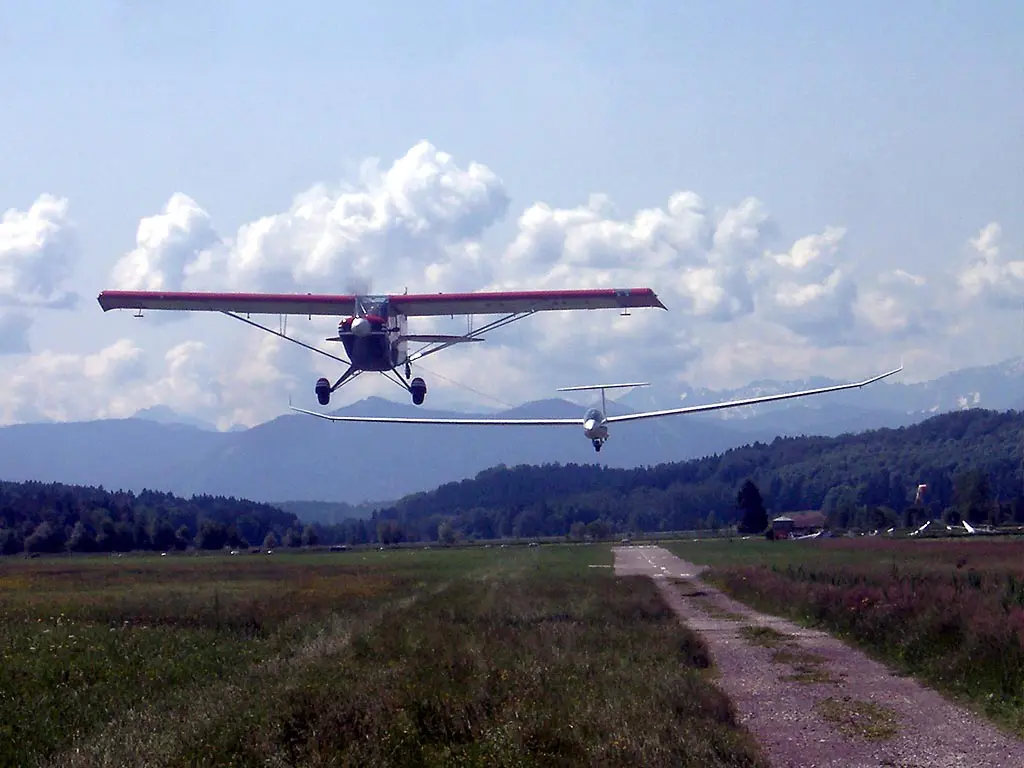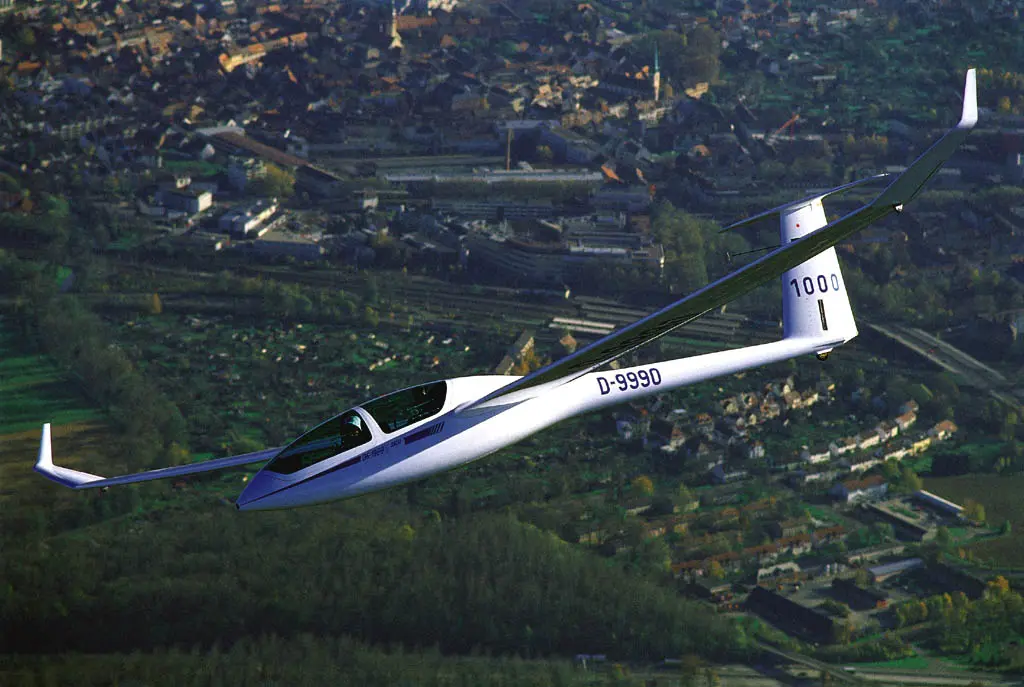Today we are going to examine flight in an airplane without an engine. You will soon understand it is safe – so safe that a person as young as 14 years of age may fly solo. It just may also be the ultimate expression of freedom.

Soaring, sometimes called gliding, is one of the purest forms of flight. Slipping silently through the sky at 5,000 feet above the ground, one can look out at the scenery below and view the landscape for miles around. There is no engine, so it is quiet. Only the sound of the variometer – an instrument that emits an audible signal and tells you whether you are in rising air currents or descending air, and the sound of the wind passing over one’s canopy. The wind sound increases as the sailplane’s speed advances, and when the sailplane slows to circle in rising air, the sound volume is reduced to a whisper.

Sailplanes do need assistance in getting launched into the air. Some sailplanes do have a small engine and can self-launch, but the rest need help to become airborne. Typically a tow plane will be used for this phase of flight. A rope, trailing from the tow plane is attached to the glider and the two aircraft depart the airfield in tandem. They stay attached until the sailplane pilot feels he can sustain his flight without any further assistance, at which time he pulls a lever that releases his aircraft from the tow rope. From that point on, he is on his own. He needs to find lift in order to stay aloft.
Sailplanes can find lift in a variety of ways. The most common form of lift is thermal lift. The energy used in this kind of lift is from rising columns of air called, thermals. Thermals form when the sun heats the earth’s surface, causing a bubble of warm air to rise into the sky, twisting as they climb. Sometimes these air columns are visible because they stir up dust on the surface. We call those dust devils. You may have observed these before without recognizing the implications of harnessing that power, but a sailplane pilot is taught to know where to look for lift and is constantly vigilant. Even when the columns of rising air are invisible, there are other signs of lift. As the warm air rises from the earth, it cools and condenses, eventually forming a cloud, a cumulous cloud. It is almost a certain sign of lift. Pilots can fly across vast distances by hopping from one cloud to another.
Once the sailplane leaves the area of lift, it will begin a gradual descent as it flies off in search of the next rising column of air. These aircraft are highly efficient. Many have a glide ratio of 40 to 1 or more. That means, for every foot of altitude they can extend the flight by 40 feet in distance. So, if the sailplane is a mile high, it could theoretically continue its gradual descent for 40 miles, in the absence of lift, before it would need to land. For a bit more information on this process, I recommend viewing this video on YouTube. Thermals develop constantly throughout the day and an experienced pilot can remain aloft for 6 hours or more. These rising columns of air typically rise to five or six thousand feet or more (perhaps as much as 10,000 feet) in the mid-western United States. In the south and western parts of the USA, much higher altitudes – as high as 18 thousand feet are common.
Another type of lift is developed when a current of wind rushes into the side of a slope, causing the air to rise mechanically as it is deflected upwards by the sloping ground. This is called ‘ridge lift’. Some of the longest sailplane flights in history have been flown in ridge lift. If the wind is blowing briskly over the Appalachian Mountains, for example, flight distances well in excess of 1,000 kilometers are possible.
The third type of lift, known as ‘wave’, or ‘mountain wave’ is similar to ridge lift but higher winds and higher mountains mean greater lift and result in higher altitudes. In America’s Mountain West, altitudes of almost 50,000 feet have been attained. But the world record for sailplane altitude was established in Argentina where the Perlan 2 sailplane has reached an altitude of more than 76,000 feet. Here is a very interesting, and well-done, short video on the Perlan 2 Project, sponsored by Airbus.

Getting back to the 14-year-old future pilot I mentioned in my opening statement, soaring represents a wonderful opportunity to engage a young person in a quest of personal adventure and achievement. Glider clubs throughout the world offer expert instruction – often free of charge to those aspiring to learn the art of soaring. There is usually a small membership fee and a charge for the use of the aircraft and tow plane, but the potential rewards are enormous. Imagine the capacity that a young person has to learn the basic mechanics of flight, to understand the engineering of the aircraft, aerodynamics, and the disciplines necessary for safe flight. Because there is no engine, a young pilot learns early on how to observe the weather conditions for lift, maintain awareness of his surroundings, evaluate his situation, and manage his aircraft’s energy all the way to a safe landing. These youngsters learn how to analyze their flights through situational awareness and how to make sound judgments as a result. These are skills most 14-year-olds do not normally learn.
I am a former Glider Instructor and I have witnessed the growth and maturity that comes with the pride of learning a new life skill. This is especially evident in young people, but not exclusive to young people. I’ve introduced long-time pilots to powerless soaring flight, and almost without exception, they have marveled at the knowledge they gained – especially as it pertains to energy management from spending a few flights in a sailplane.
If you know of someone who may enjoy learning to fly sailplanes, I am providing a link here to the Soaring Society of America. Here you can locate a glider club near you and embark upon an unforgettable adventure.
Welcome to 3-Minutes A Day University, where every day you can learn a little about a lot of things in three minutes or less. We help you expand your knowledge and understanding of the real world and 3-MAD University is tuition-free. Our wide-ranging syllabus includes fascinating insight into topics including Health and Medicine, Science, Sports, Geography, History, Culinary Arts, Finance and the Economy, Music and Entertainment, and dozens more. You will impress yourself, your friends and your family with how easy it is to learn facts and perspectives about the world around you. One topic you will never find covered is politics. We hope you enjoyed the previous three minutes.

Was this email forwarded to you? Subscribe Here.
© Copyright 2024. 3-Minutes A Day University All Rights Reserved.


Rick
Brings back good memories!
176057401
It sure does, Rick!